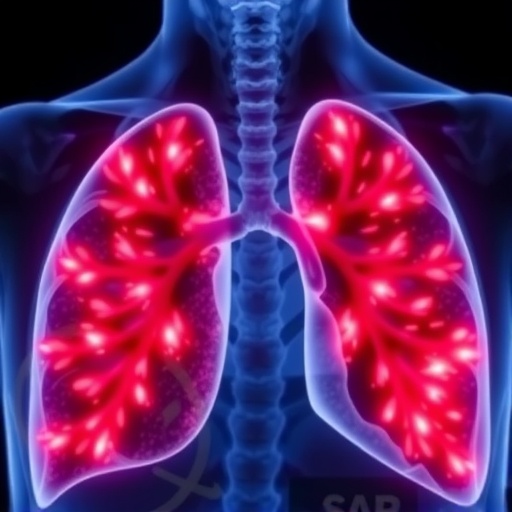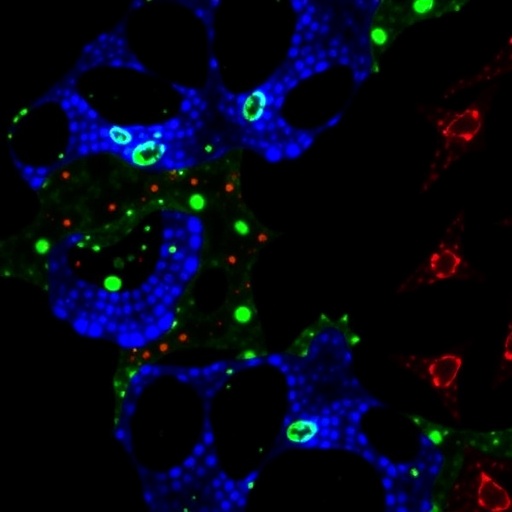In the evolving landscape of lung cancer treatment, a groundbreaking study has shed new light on the interplay between genetic mutations and immunological markers in determining the efficacy of postoperative radiotherapy (PORT) for patients diagnosed with stage III-pN2 non-small-cell lung cancer (NSCLC). This research underscores the nuanced roles of epidermal growth factor receptor (EGFR) mutations and programmed death-ligand 1 (PD-L1) expression in tailoring radiotherapeutic strategies, marking a significant step toward personalized oncology.
NSCLC, accounting for the majority of lung cancer cases worldwide, often demands multimodal treatment approaches. Surgical resection remains a cornerstone of therapy for patients with stage III-pN2 disease; however, the decision to administer PORT post-surgery has long been controversial due to inconsistent survival benefits and concerns regarding treatment-related morbidity. The pressing clinical question has been: which subsets of patients might derive tangible benefits from adjunctive radiotherapy following complete tumor resection?
This retrospective analysis, conducted on 251 patients treated between 2018 and 2023, rigorously evaluated how the molecular landscape—specifically EGFR mutation status and PD-L1 expression—modulated response to PORT. These biomarkers are pivotal in the pathobiology of lung cancers; EGFR mutations drive oncogenic signaling pathways, while PD-L1 plays a crucial role in immune evasion mechanisms, influencing the tumor microenvironment’s response to immunologic interventions.
The investigators meticulously divided the patient cohort based on EGFR and PD-L1 statuses, comparing disease-free survival (DFS), overall survival (OS), and locoregional recurrence (LRR) outcomes between those who received PORT and those who did not. The median follow-up period extended just over two years, allowing for a substantive assessment of mid-term oncologic control.
Among the entire study population, PORT users demonstrated a noticeable trend toward prolonged DFS compared to non-users, albeit without reaching conventional levels of statistical significance. This subtle effect suggested that while PORT might confer clinical benefits, its efficacy could be contingent on specific tumor biological characteristics rather than a one-size-fits-all application.
Deep dive subgroup analyses revealed compelling findings: patients harboring wild-type EGFR tumors experienced significantly enhanced DFS following PORT. The median disease-free period nearly doubled in this group, pointing to a pronounced radiosensitivity seemingly dependent on the absence of activating EGFR mutations. Conversely, EGFR mutant cases showed no appreciable survival advantage, implicating intrinsic resistance mechanisms or alternate oncogenic drivers mitigating the benefits of radiotherapy.
Similarly, PD-L1 expression emerged as a potent predictive marker in this context. Patients with PD-L1 positive tumors derived substantial prolongation in DFS with PORT, whereas PD-L1 negative individuals did not. This dichotomy underscores the complex interaction between tumor immunobiology and radiation-induced cell death, possibly reflecting the capacity of an active immune microenvironment to synergize with radiotherapeutic cytotoxicity.
Notably, the study also illuminated the impact on locoregional control, a critical determinant of long-term disease management and patient quality of life. PORT was associated with a marked reduction in LRR rates in the overall population, accompanied by pronounced reductions in EGFR wild-type and PD-L1 positive subgroups. These results suggest that PORT may serve not only to delay systemic progression but also to control local disease, which often predisposes patients to morbidity and mortality.
However, in EGFR mutant and PD-L1 negative patients, PORT failed to significantly mitigate locoregional recurrences, reinforcing the notion that tumor biology decisively influences radiotherapy responsiveness. This compels a reconsideration of current clinical protocols, advocating for biomarker-driven strategies to optimize therapeutic efficacy and minimize unnecessary toxicities.
Importantly, the study employed robust statistical methodologies, including Kaplan–Meier survival analyses, Cox regression models, and competing risk frameworks, enhancing the reliability of the conclusions. The meticulous stratification based on molecular markers reflects the advancing era of precision oncology, where treatment algorithms increasingly integrate genetic and immunological profiling.
These findings hold profound clinical implications. Incorporating EGFR and PD-L1 testing into postoperative decision-making could revolutionize patient selection for PORT, aligning treatment intensity with the underlying tumor biology. Such precision could maximize therapeutic gains while sparing patients unlikely to benefit from the added morbidity of radiation exposure.
Furthermore, this research highlights the intricate crosstalk between oncogenic mutations and the tumor immune environment in dictating radiotherapeutic outcomes. Understanding these interactions may unlock new avenues for combinatorial therapies that integrate targeted agents or immune modulators with radiation to overcome resistance and enhance tumor eradication.
The significance of PD-L1 as a biomarker in radiotherapy response also carries potential repercussions for emerging treatments, particularly in the integration of immune checkpoint inhibitors. PD-L1 positivity as a predictor of PORT benefit suggests that certain immunologically “hot” tumors are more susceptible to radiation-induced immunogenic cell death, potentially amplifying antitumor immune responses.
While this study is retrospective and therefore subject to inherent limitations, including potential selection biases and heterogeneity in adjuvant treatments, its large sample size and comprehensive biomarker analyses provide a robust foundation for future prospective trials. Validation of these findings in controlled settings will be instrumental in establishing definitive clinical guidelines.
As lung cancer treatment paradigms evolve, the identification of reliable biomarkers to guide postoperative therapies is paramount. The integration of EGFR mutation and PD-L1 status into radiotherapy planning exemplifies the strides being made toward individualized cancer care, and the promise it holds for improving outcomes in aggressive malignancies like stage III-pN2 NSCLC.
The research community eagerly anticipates subsequent studies building on this foundation, exploring combinational therapies and novel biomarkers that may refine patient stratification further. Meanwhile, these findings offer immediate translational potential, encouraging clinicians to consider molecular profiles when deliberating PORT.
In conclusion, the study conducted by Yao et al. represents a landmark contribution to the nuanced understanding of how genetic and immunologic tumor characteristics influence postoperative radiotherapy efficacy. By delineating the subpopulations most likely to benefit—specifically EGFR wild-type and PD-L1 positive patients—it paves the way for more personalized, effective, and less toxic treatment regimens for individuals battling stage III-pN2 non-small-cell lung cancer.
Subject of Research: The role of EGFR mutation and PD-L1 status as biomarkers affecting the efficacy of postoperative radiotherapy in completely resected stage III-pN2 non-small-cell lung cancer.
Article Title: The impact of EGFR mutation and PD-L1 status on the efficacy of postoperative radiotherapy in stage III-pN2 NSCLC.
Article References:
Yao, J., Geng, Y., Xu, J. et al. The impact of EGFR mutation and PD-L1 status on the efficacy of postoperative radiotherapy in stage III-pN2 NSCLC. BMC Cancer 25, 858 (2025). https://doi.org/10.1186/s12885-025-14255-0
Image Credits: Scienmag.com
DOI: https://doi.org/10.1186/s12885-025-14255-0
Tags: EGFR mutations in lung cancerimmune evasion in non-small-cell lung cancerinfluence of genetic mutations on radiotherapy successmolecular biomarkers in cancer treatmentmultimodal treatment approaches for lung canceroptimizing treatment strategies for NSCLC patientsPD-L1 expression and radiotherapypersonalized oncology in lung cancerpostoperative radiotherapy in NSCLCretrospective analysis of lung cancer treatmentsstage III-pN2 non-small-cell lung cancersurvival benefits of adjunctive radiotherapy





